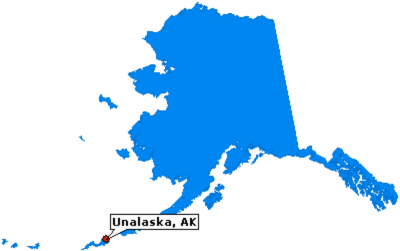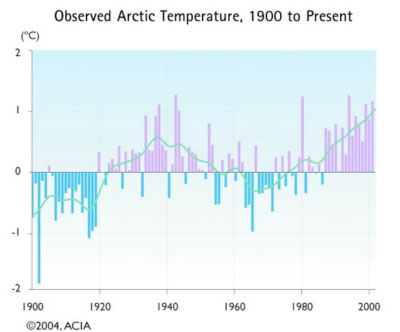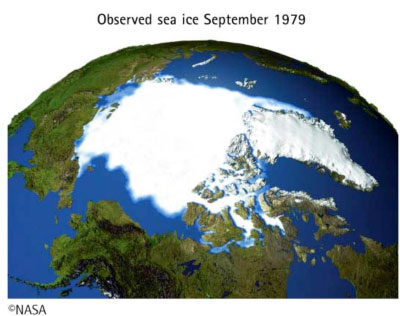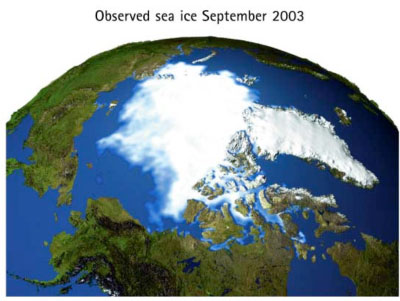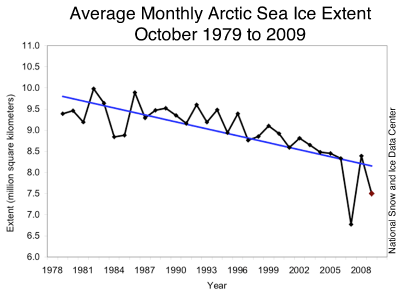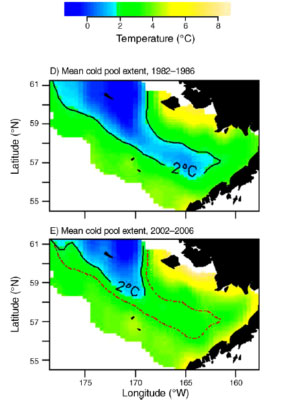This paper was written as part of the 2010 Alaska Oceans Sciences Bowl high school competition. The conclusions in this report are solely those of the student authors.
The Impact of Receding Sea Ice on the Unalaska Snow Crab Industry
Authors
Team B.E.A.N.
Abstract
The Bering Sea is greatly impacted by receding sea ice. Many communities depend on the Bering Sea for resources. Thus, receding sea ice has a large affect on said communities. In order to adapt to receding sea ice and the changes it brings, the communities must first understand what they are and how they affect their resources. One of said communities is the island of Unalaska, located just on the southern edge of the Bering Sea. As the largest fishing community in the Bering Sea, Unalaska's economy depends greatly on the Bering Sea ecosystem. Any change in said ecosystem could drastically hinder Unalaska's fishing industry, and therefore land a major blow to Unalaska's economy.
The sea ice of the Bering Sea is a very important abiotic factor. As it recedes north, so too does the entire ecosystem that the ice supports. As the ecosystem moves away from Unalaska, it becomes more difficult to fish in that ecosystem. One of the species caught in the Bering Sea ecosystem is snow crab (Chionoecetes opilio). Snow crab are dependent on a natural phenomenon called the "cold pool," an area of cold water along the northern Bering Sea Shelf. The sea ice maintains the "cold pool." As the sea ice recedes north, so does the "cold pool," and so do the snow crab.
Although it may not be possible to change what is happening to the sea ice, there is always the ability to adapt to it. The reports of important officials in the marine biology and fishing fields, as well as various articles that talk about the problem, help describe some possible alternatives that could help Unalaska adapt to the problem that the receding ice causes.
The Impact of Receding Sea Ice on the Unalaska Snow Crab Industry
The city of Unalaska is located on the island of Unalaska in the Aleutian Islands Chain in southwest Alaska (Figure 1). The Aleutian Islands make up the southern border of the Bering Sea, which extends north to the Arctic Circle. Unalaska is a city of approximately 4,000 permanent residents and 3,000-5,000 transient workers. The city of Unalaska is extremely isolated with the closest larger city being Anchorage, Alaska located approximately 900 miles northeast by plane. This isolation results in a high cost of living because everything must be flown or shipped to Unalaska. This high cost of having a functioning town in Unalaska is supported by the funds produced by the many fisheries that are based out of Unalaska. Unalaska has been ranked as the largest fishing port in the United States by volume of product that crosses its docks (http://www.unalaska.info/). The city of Unalaska and its residents depend on the fishing industry for their livelihood. The value of these Bering Sea fisheries allows the city of Unalaska to be a relatively affluent community despite the high costs associated with its isolated location. One of the fisheries based out of Unalaska is the snow crab fishery. This industry has experienced a significant down turn in recent years. One of the main reasons for this down turn is the receding sea ice. The purpose of this paper is to define the effect of receding sea ice on the snow crab fishery, how this will effect the economy of Unalaska, and what policies changes should considered in address the problem of sea ice receding and the result on the snow crab fishery.
Unalaska Industry
In 2008, the Alaska seafood harvest was worth a record $1.7 billion (Unalaska Fisheries Report). This amount represents many fisheries from the Bering Sea and the northern Pacific Ocean. The city of Unalaska is ideally located to be a significant part of the Alaskan fishing industry. Unalaska is the largest deep-water port in the Aleutians and the northern most deep-water port that is ice-free year round.
The city of Unalaska fishing industry includes approximately 36 fisheries. The value of these fisheries varies greatly depending on the amount of product obtained from year-to-year and the value of the product, which is affected by worldwide demand. The city's income is derived from taxes relating to the fisheries industry, $12,403,768 in direct taxes, and other taxes that are directly affected by the health of the fishing industry, $10,316,667 in property and sales taxes. The total income for the city is $37,043,211 with $22,720,435 coming directly or indirectly from the fisheries industry (Unalaska Budget FY10, p. 34).
Frank Kelty, Resource Manager for the City of Unalaska, said that in 2009 the snow crab quota was around 48 million pounds with a final value of around $1.70 per pound giving the total 2009 industry a value of $81.6 million. Approximately, 3.5% of this comes back into the city in the form of various taxes and indirect revenues for a total approximately value of $2.85 million for the city of Unalaska, which represents 7.7% of the total revenue for the city of Unalaska. Additionally, two-thirds of the snow crab sold in the United States comes from the Unalaska fisheries that catch snow crab. Snow crab is a popular food because of its low fat and high protein content. If the snow crab industry were to decline, the amount of snow crab in the United States would drastically decline.
The value of the snow crab fisheries is kept up by the fact that the cost of harvesting the snow crab is relatively low. Many of the ships that fish the industry are based in Unalaska and are able to move to the edge of the sea ice shelf where the snow crab live. As the ice shelf retreats, the snow crab, who are dependant on the "cold pool" move with it (Orensanz et al. 2004). The cost of harvesting the snow crab goes up, as the fishing fleet needs to move farther north to catch the snow crab. The future receding of the ice shelf in the Bering Sea will increase the cost of fishing for the snow crab.
Problem Statement:
Climate Change and Receding Sea Ice
The biggest contributing factor to receding sea ice is climate change. As global temperatures increase, the earth gets warmer and there is less ice in Arctic areas. Since the 1960s, annual average temperatures have warmed up to 1.8°F (1.0°C) per decade, with winter warming as high as 3°F (2°C) per decade (Figure 2).
There is no question that Arctic temperatures have been increasing over the last few years. In addition to a decreased extent of winter sea ice, the warming temperature causes sea ice to melt earlier than normal. Though the term "recede" in this context is somewhat misleading and the sea ice is generally not moving north. The sea ice is formed in the northern Bering Sea where it is then blown southward by the prevailing north-northeasterly winds. There is a point in the Bering Sea that is below the freezing point of seawater (-1.7°C). When the ice, blown by the winds, reaches this point, it melts. This is where the sea ice's extent ends. When we use the word recede, we mean that this melting line is moving farther north, which causes the sea ice to not extend as far south. Sea ice in the Arctic has decreased significantly in the last 30 years (Figure 3). Though the late-April ice edge has been variable of the past decade (Figure 4), the movement of sea ice will directly impact the species the exist in this ecosystem (Mueter and Litzow 2008). The physiological tolerance of Arctic and Subarctic species will define the extent of their spatial heterogeneity. It follows that a decrease in sea ice would cause a resultant change in the biological community below it. According to the National Snow and Ice Data Center, there is a 5.9% decline per decade of the sea ice extent (http://nsidc.org/arcticseaicenews/).
Now that we understand that sea ice has been receding quite a bit in the last several years, we must consider what affects this receding sea ice has on our community. Fish and crab may not live on the ice or right under the ice, but that doesn't mean that they aren't affected by the ice receding. There is a delicate balance between the sea ice and the fish and crab.
Receding Sea Ice and the Cold Pool
Sea ice is frozen seawater. When seawater freezes, the ice does not absorb the salt that was previously in the seawater. Instead, the water underneath the ice absorbs that salt. This causes the water underneath the ice to have an increased salinity. This process is known as brine rejection. Brine rejection is important in the formation of the "cold pool," an area of cold water in the Bering Sea. One area, the St. Lawrence Island Polynya, is especially important in the maintenance of the "cold pool." A polynya is an area of open water in the sea ice. Polynyas form in the sheltered areas of islands or coasts. When formed, polynyas expose unfrozen water the cold air. The exposed water freezes and is blown away, exposing more unfrozen water, and the process repeats. The cold, dense, and salty water that is a byproduct of this repeated ice creation provides organic matter to the benthos, where snow crab live. Without the sea ice and polynyas, the benthos, the region the snow crab inhabit, would be devoid of food. The movement of the cold pool is dependant on the sea ice above it and changes based upon the extend of that sea ice (Mueter and Litzow 2008, Figure 6).
Snow Crab Diet, Sea Ice, and the Cold Pool
The main issue regarding the "cold pool" and the snow crab is food. Snow crab eat fish, clams, worms, brittle stars, shrimp, and other crab (http://www.dfo-mpo.gc.ca/media/back-fiche/2003/snowcrab-eng.htm). Most of the organisms that crab eat feed on algae. When sea ice is present, these algae bloom under the sea ice in early spring. Because of the "cold pool," there are not many creatures around to eat the algae. The algae then die and drift to the bottom, where they become an important part of the benthic food web. These dead algae feed the snow crab prey, which feed the snow crab.
Without the sea ice, the algae do not bloom until later. Because the sea ice is not present, neither is the cold pool, which means fish like pollock and cod are able to eat the algae before they die and float to the bottom which results in a net food deficiency in the benthic zone, meaning few crab will survive. For this reason, the snow crab need sea ice, and the cold pool, to survive. This is why the snow crab must follow the cold pool.
Policy Changes and Actions
The snow crab industry is very important to the economy of Unalaska. The snow crab industry consists of about 7.7% of the tax money made by Unalaska. Other fisheries such as the pollock and king crab make up a larger portion of this tax money, but the snow crab is a good representation of the various fisheries. Snow crab are not the only fish caught in Unalaska affected by receding sea ice, but similar fisheries are affected in similar ways. Although we may not be able to fix the problems regarding the snow crab, receding sea ice, and cold pool, there are ways to adapt to these changes. One way of doing this is by taking measures to increase the fuel efficiency of ships. Another way to adapt to the moving snow crab is to find ways to increase the value of the product in order to make up for the higher expense of getting to the crab. Diversifying the economy could also help, taking emphasis off of the snow crab and focusing more on other methods of making money.
There are many movements out today that encourage commercial fishing boat owners to increase their boat's fuel efficiency. The California Technology, Trade, and Commerce Agency is administering the "Fishing Vessel Fuel Conservation Loan Fund," a fund that is dedicated to loaning owners of commercial fishing boats money to increase the fuel efficiency of their boats to cut down on fishing costs. According to Sea Grant Fisheries Specialist Dr. Christopher Dewees, "For some fishing vessels, fuel is the biggest variable expense; a 10 or 15 percent increase in fuel efficiency is significant." Boat owners who partook in the loan program were able to increase their vessel's fuel efficiency by 15 to 17 percent (http://www-csgc.ucsd.edu/NEWSROOM/NEWSRELEASES/FuelEffic.html). If Unalaska were to implement a similar loan program for it's various fisheries and boat owners, the increase cost of retrieving the snow crab could be drastically reduced.
Snow crab is not Unalaska's only commercially caught sea creature. One of the other major harvested fish of Unalaska is pollock. Pollock bring in an even larger amount of money than snow crab do. However, if snow crab, and other similar crab, were to rapidly decline, Unalaska's economy would take a blow. Even if that did happen and snow crab industry was to completely fail, which is unlikely, there would still be other fish that could support Unalaska's economy.
Conclusions
This paper has shown that receding sea ice does, indeed, have a very noticeable impact on the snow crab industry of Unalaska. This, in tern, causes several other affects not only in Unalaska, but the United States as a whole as well. As sea ice recedes, so does the underwater phenomenon known as the "cold pool." As this "cold pool" recedes with the sea ice, the snow crab that live off of the "cold pool" move with it. As the snow crab move farther north, it becomes more expensive for fisheries to catch them. As this trend continues, it will result in a decline in tax revenue that Unalaska receives from the fishing industries that catch snow crab.
While this reduction in snow crab revenue represents a relatively small amount of Unalaska's total tax revenues, the snow crab serve as a representation of other Arctic ecosystem changes that will have similar effects on other crab and fish industries. Other ecosystems like the North Sea have experienced similar shifts in important commercial fisheries and will likely be facing similar problem with northward movement of species (Perry et al 2005).
Figures
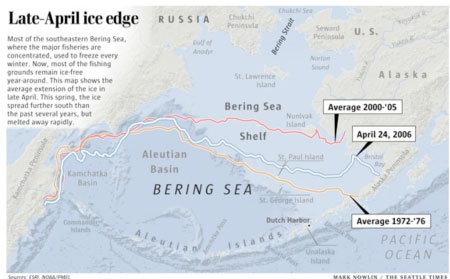
Figure 4. The late-April ice edge of the Bering Sea showing the extend of sea ice from the 1970's to the present.
References
- City of Unalaska Website, Unalaska Fisheries Report http://unalaska-ak.us/index.asp?Type=B_PR&SEC={235B058F-0EF7-4F54-BF34-252A734D8B20}&DE={FA07B0E9-06C3-4083-A203-3FA68CDB0C7F}
- City of Unalaska Website, Budget FY10 http://unalaska-ak.us/vertical/Sites/{0227B6A7-A82F-4BFC-9D02-A4B2D3A8BC35}/uploads/{CAA32AC3-1F7E-4C3F-B1CA-F81F29CAF90A}.PDF
- Kelty, F. (Personal Communication) City of Unalaska, Resource Manager, PO Box 610, Unalaska, AK 99685, 907-581-1251.
- Mueter, F.J. and M.A. Litzow. 2008. Sea Ice retreat alters the biogeography of the Bering Sea continental shelf. Ecological Applications 18(2), 309-320.
- Orensanz, J., B. Ernst, D. Armstrong, P. Stabeno, and P. Livingston. 2004. Contraction of the geographic rand of the distribution of the snow crab (Chionoecetes opilio) in the eastern Bering Sea: an environmental ratchet? CalCOFI Reports 45, 65-79.
- Perry, A.L., P.J. Low, J.R. Ellis, and J.D. Reynolds. 2005. Climate change and distribution shifts in Marine Fishes. Science 308, 1912-1915.

